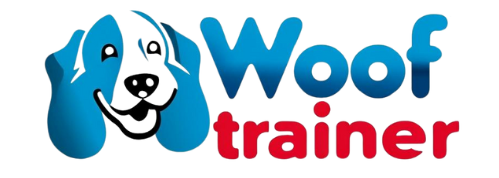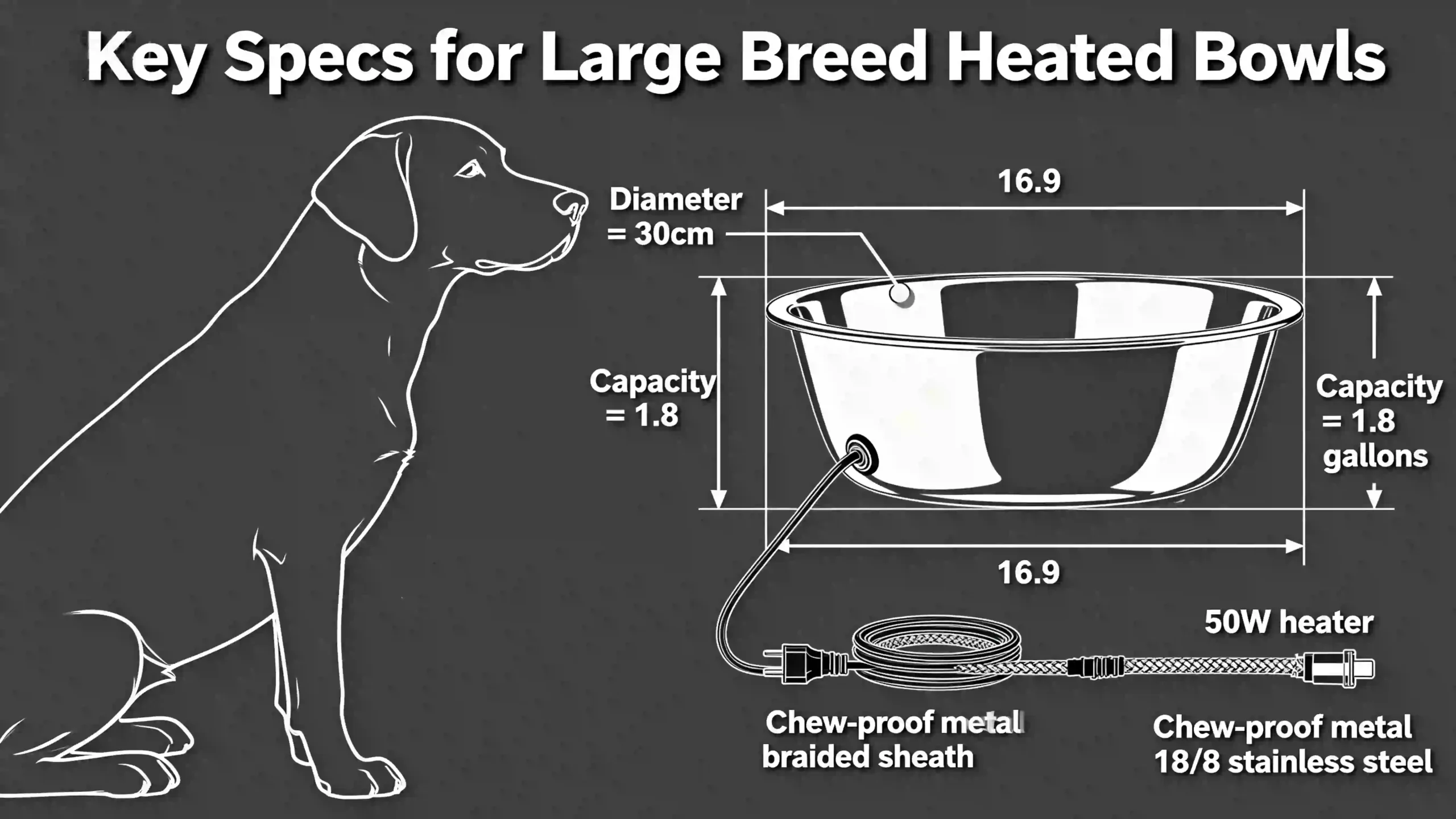A Tutorial for Cold Winters & Big Breeds.
Winter in the suburbs brings many joys—but for owners of large breeds like Labrador Retrievers, Huskies, or Shepherds, it also brings a challenge: keeping water available and drinkable outdoors. When temperatures dip well below freezing, ordinary bowls ice over, leaving dogs thirsty, which can cause health problems—not to mention inconvenience for the owners. A heated dog bowl can be a game-changer. This tutorial walks through what matters when choosing one for large dogs: size, safety, materials, power, usability—and shows how to pick the right one that offers both peace of mind and long-term value.
Why Winter Hydration Matters, Especially for Large Breeds
Before you choose a warm or heated bowl, it helps to understand how much water your large dog needs in cold weather, and what risks under-hydration carries.
- A common guideline: a healthy adult dog needs about 1 ounce of water per pound of body weight per day. For example, a 70-lb Labrador should drink ~70 ounces (~8.75 cups) daily.
- The colder weather can trick both dogs and owners: snow or frozen water may reduce actual intake even if water is technically “available.”
- Low water intake can lead to urinary tract issues, dehydration, or kidney strain, especially in high-activity large breeds living outdoors or semi-outdoors.
So, a heated dog bowl isn’t just a comfort: it’s part of responsible dog care in sub-zero conditions.
Key Features to Consider in a Heated Dog Bowl for Large Dogs
For a large breed in a cold winter climate, not all heated bowls are equal. Here’s what to prioritize.
| Feature | Why It Matters | What to Look For |
|---|---|---|
| Capacity & Bowl Size | Large breeds drink more in one go; you don’t want to be refilling constantly, especially outdoors in snow or ice. The bowl should hold enough water to meet the dog’s needs for several hours. | Aim for at least 1-2 gallons capacity outdoors, or something that gives at least ½-day worth of water. The diameter should allow easy access for a big snout, without forcing the dog to spill or slide the bowl. Height should be reasonable so the dog can reach without bending excessively (depending on the dog’s shoulder height). |
| Material & Build Quality | Cold temperatures, rough handling (digging, stepping), chewing, and potential for damage from freezing can all damage lesser materials. Also, surfaces must stay clean. | Prefer food-grade stainless steel or high-grade metal; avoid plastic if possible (plastic can crack, warp, and harbor bacteria). Look for thick gauge steel, durable welds or seals, rubber bases or stabilizing features so the bowl doesn’t tip. Also insulated or double-walled options help. |
| Heating Element, Thermostat & Temperature Range | You want water kept above freezing but not scalding, even when outside temperatures are very low. Also you want it to save power and be safe. | Thermostatic control (turns on/off based on water / ambient temp). A heating element rated for low voltages or with UL / CE / CSA certification. Temperature range that keeps water ~0-20 °C (32-68 °F). Wattage balanced to avoid over-draw. |
| Power, Wiring & Safety | A heating element is only safe and convenient if the power supply is reliable and risks (electrical, chew, weather) are minimized. | Low voltage units are safer. Weatherproof wiring, chew-resistant cord casing, grounded plugs or GFCI protection outdoors. Cord long enough so device can be placed where plug is accessible but safe. |
| Ease of Cleaning & Maintenance | Snow, debris, algae, bacteria build up quickly. The bowl must be easy to clean in harsh conditions. | Removable parts, stainless steel surfaces, minimal crevices, sealed heating elements so water cannot seep into electronics, good instructions. |
| Durability & Warranty | Cold winters stress materials; things freeze, expand, suffer stress. If the bowl fails, you’d rather have a backed product. | Look for warranty, good customer reviews particularly concerning winter performance, support in your region, replacement parts if needed. |
Putting It All Together: Meet Wooftrainer Heated Bowl
WoofTrainer Heated Dog Bowl — heavy-duty hydration solution built to tackle the harshest winter conditions. Crafted from food-grade 18/8 stainless steel (30 cm in diameter and 10 cm high), it ensures both durability and easy cleaning. Its core appeal lies in its safety and performance features: unlike high-voltage alternatives, it operates on a 24-V low-voltage supply, eliminating the risk of electrical shock to pets and humans. Performance is guaranteed by a powerful 50 W heating element that keeps water within an optimal 0 °C to 20 °C range, even in temperatures as low as –20 °C. For longevity and safety, the 1.3-meter power cord is protected by a chew-resistant stainless steel wrap, and the base is fitted with a rubber ring to prevent tipping. Offering superior safety, stability, and enduring performance, it is an ideal hydration solution for both dogs and livestock alike.
This combination of material, size, heating capacity, low voltage, and rugged safety features hits nearly all the criteria listed above, making it an excellent real-world fit for large dogs in cold suburban or rural settings.
Step-by-Step Guide: Choosing the Right Heated Bowl
Here’s a practical step sequence for homeowners deciding which heated bowl to buy.
1.Measure Your Dog
- Shoulder height and snout width: helps determine appropriate diameter.
- Daily water intake under cold conditions: use guidelines (e.g. 1 oz per lb) and factor in lower drinking due to cold.
- Location (indoors, outdoors, kennel, porch, barn): conditions (wind, snow, exposure) matter.
2.Decide Size & Capacity You Need
- For example, a 65-lb Labrador might need 7-10 cups/day (approx. 1.75-2.5 L). If you refill twice/day, need a bowl that holds ~1.5-2 L plus buffer. For outdoors, more buffer.
- Consider diameter to prevent tipping and allow comfortable drinking.
3.Choose Material & Build Quality
- Stainless steel preferred; food-grade (304 or better) materials.
- If plastic is used, ensure BPA-free, thick walled, UV stabilized. Ceramics only if heavy and lead-free.
- Rubber or weighted base helps stability.
4.Check Heating & Power Specs
- Low-voltage units are safer, especially outdoors.
- Thermostatic control is a plus.
- Ensure cord is protected, ideally chew-resistant. Cord length suitable. Plug type acceptable outdoors, possibly GFCI protected.
- Wattage enough to overcome ambient cold (e.g. 50 W or more, depending on exposure).
5.Safety Features
- Voltage safety.
- Insulation.
- Tip resistance.
- Waterproof or sealed electronics.
- Regulated power supply (UL, ETL, CE, etc).
6.Practical Usability
- Ease of cleaning.
- Access to water during the day/night.
- How often you will refill or unplug.
- Storage in summer (some bowls double as regular water bowls if unplugged).
7.Compare Costs & Warranty
- Upfront costs vs long-term durability and energy costs.
- Warranties for outdoor use, cold damage, cord damage.
- Parts replacement.
Common Mistakes & How to Avoid Them
- Buying a bowl that’s too small: leads to frequent refills, and in cold weather water may freeze before refill opportunity.
- Over-powering vs under-powering: too little heat, bowl freezes; too much heat, risk of scald or wasted energy.
- Cheap plastics: may crack, warp, or degrade, possibly leach; difficult to clean.
- Ignoring safety of wiring: exposed cords near snow, salt, or chew can be dangerous.
Winter Hydration Tips & Best Practices
To ensure your large dog stays properly hydrated in cold weather, beyond picking the right heated bowl:
- Monitor intake daily. Mark refill amounts; see if consumption drops in very cold weather.
- Place bowl in sheltered spots. Wind chill, snow drift, and direct exposure can still freeze water faster. A porch or alcove helps.
- Clean frequently. Even in winter, bacteria, algae, or debris accumulate—use stainless steel brushes, hot water.
- Check for ice / slush around bowl. Frozen ring at water surface may discourage drinking. Scrape ice gently.
- Maintain water temperature. Water that is just above freezing (~0-5 °C) is more palatable than water that’s borderline iced over or scalding.
- Have backup. On especially cold nights or during power outages, keep a non-powered insulated bowl or bring water indoors.
Example Decision Matrix
Here’s how a suburban Labrador owner in Northern Europe might use this process:
| Spec | Labrador Retriever (30-35 kg) | Winter Conditions: -15 to -25 °C, porch exposure |
|---|---|---|
| Daily water needs | ~50-60 oz / ~1.5-2 L per day | Increase buffer because dog may drink less if water too cold |
| Capacity desired | Bowl holds ~2.5-3 L to allow refill twice/day outdoors | Want bowl diameter ~30-35 cm so snout easily accesses without mess |
| Material | Food-grade stainless steel, thick gauge, rubber base | Withstands snow, freezing, knocks |
| Heating power | 40-60 W with thermostat, low voltage preferred | To maintain water above 0 °C even at -20 °C outside |
| Safety | Sealed heating element, low voltage, chew resistant cord | Safe plug, insulated cord, durable wiring, tip-proof |
| Budget & durability | Moderate budget, expect 3-5 winters use | Warranty, spare parts, energy cost considered |
Using these specs, the WoofTrainer Heated Dog Bowl fits nicely: capacity, material, heating performance, safety.
Concluding Thoughts
For large breeds in cold suburban or rural areas, a well-chosen heated dog bowl is more than just a convenience—it’s a health investment. When owners focus on adequate bowl size, safe durable materials, proper heating controls, and real-world safety features, they can avoid common frustrations: ice-clogged bowls, constant refills, or unsafe components.
The WoofTrainer Heated Dog Bowl, for example, offers a combo of features (food-grade stainless steel, low voltage, high heating capacity, chew-resistant cord, stable base) that align closely with what winter conditions demand. Pair one of these bowls with sound winter hydration practices (monitoring intake, cleaning often, allowing for access), and a large breed dog stays well-hydrated, comfortable, and healthier through the cold months.
FAQ
-
How large should a heated dog bowl be for a Labrador?
A Labrador weighing 60-70 lb typically drinks about 60 ounces (~8-9 cups) per day under normal conditions. In winter, water consumption may drop unless the water stays unfrozen. Choose a bowl that holds at least half that for one refill or more (≈ 1.5-2 L), and with a diameter that fits the dog’s muzzle comfortably. -
Is stainless steel really better than plastic or ceramic for heated bowls?
Yes. Stainless steel is non-porous, more hygienic (resists bacteria and odor buildup), durable (resists cracking or warping), and tolerates heat changes better. Plastic may degrade, absorb odors, or leach chemicals; ceramics can chip or crack, especially in freezing conditions. Veterinary sources generally favor stainless steel. -
Can a heated bowl keep water from freezing in -20 °C temperatures?
With the right specifications, yes. A powerful heating element (e.g. ~50 W), good insulation, thermostatic control, and safe low-voltage supply can keep water from freezing even in -20 °C, provided the bowl is well sheltered from wind. Some products like the WoofTrainer claim to do so. -
Are low voltage heated bowls safer?
Generally, yes. Low voltage (e.g. 24 V) reduces the risk of electrical shock. If combined with proper insulation, sealed heating elements, and reliable manufacturing, low‐voltage bowls are markedly safer outdoors and in wet or snowy conditions. -
How often should the heated bowl be cleaned and maintained?
Ideally, rinse daily, clean thoroughly (hot soapy water) every 1–2 days, and inspect wires/cords weekly. In winter, debris from snow or ice may introduce grit or salts, so more frequent cleaning helps prevent corrosion or damage. -
Do standard heated bowls work well for Huskies or Shepherds too?
Yes— just ensure the bowl is large enough, strong enough, and the heating system is sufficient. Huskies and Shepherds tend to drink much, especially after exercise or exposure. Also, their snouts may be narrower or shorter, so diameter and bowl depth must fit their muzzle shape. -
What about using buckets or heated water tanks instead of bowls?
If your dog spends long periods outdoors (barns, runs), or if there are multiple large dogs, heated buckets or tanks might be more suitable. However, bowls are easier for individual pets, clean more easily, and use less energy. For those more permanent outdoor setups, Heated Dog Bowls vs Heated Buckets: Which Fits Your Lifestyle is a useful comparison. -
Will a heated bowl prevent drinking water from becoming too warm or unpalatable?
It can, provided it has a thermostat or control mechanism. Dogs often prefer water closer to room temperature (around 5-20 °C in cold climates). Bowls that overheat may become warm to the touch or have a risk of creating biofilm or bacterial growth. Always check the specifications: bowls like WoofTrainer that limit water temp to ~ 20 °C upper are desirable.
Comparison with Other Options
Sometimes a bowl isn’t enough, depending on how exposed your dog’s water source is, or your lifestyle.
- Heated Dog Bowls vs Heated Buckets: Which Fits Your Lifestyle — if your dog is kept more in a barn or outside enclosure, a heated bucket or tank might be more appropriate. Bowls are more manageable for porches, patios, or when dogs come in and out.
- How to Pick a Non-Toxic Heated Dog Bowl for Your Pup — choosing materials that are food-grade, non-leaching, safe wiring, and avoiding toxic plastics or finishes.
- Heated Dog Bowls: The Complete Guide to Keeping Pets Hydrated in Winter — for a broader view, including watering frequency, warm vs room temperature water, usage of insulating covers.


